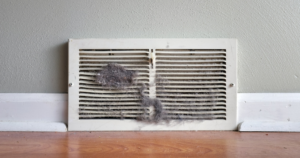Air ducts play a vital role in heating, ventilation, and air conditioning (HVAC) systems, ensuring the efficient delivery and removal of air. Understanding the purpose of air ducts is essential for maintaining indoor air quality, thermal comfort, and energy efficiency in homes and buildings. In this blog, we will delve into the functions and significance of air ducts, exploring their role in HVAC systems and the materials used in their construction.
What Are Air Ducts and Ductwork?
Air ducts, or ductwork, are conduits or passages that facilitate air movement within HVAC systems. They provide pathways for various airflows, including supply, return, and exhaust air. Ducts are designed to ensure acceptable indoor air quality and thermal comfort by delivering ventilation as part of the air supply. A duct system’s planning, sizing, and optimization are called duct design.
Importance of Air Ducts in HVAC Systems
Air ducts play a crucial role in HVAC systems by performing the following functions:
a) Air Distribution: Air ducts transport conditioned air from the central heating or cooling unit to different building areas. They ensure even air distribution, maintaining consistent temperatures throughout the space.
b) Ventilation: Ducts deliver ventilation air, which helps remove pollutants, odors, and excess moisture from indoor spaces. This process contributes to maintaining good indoor air quality.
c) Return Air: Return air ducts retrieve air from various rooms and circulate it back to the HVAC system for treatment, filtration, and reconditioning. This recirculation process improves energy efficiency and reduces the workload on the heating or cooling unit.
Materials Used in Air Duct Construction
Air ducts can be made from different materials depending on cost, performance requirements, and building regulations. Some common materials include:
a) Galvanized Steel: Galvanized mild steel ducts are widely used due to their durability, strength, and resistance to corrosion. The zinc coating on galvanized steel aids in stopping rust and eliminates the need for expensive painting.
b) Aluminum: Aluminum ducts offer a lightweight alternative to galvanized steel. They are known for their excellent thermal conductivity and resistance to corrosion.
c) Flex Ducts: Flex ducts are flexible and easy to install in tight spaces. They consist of a flexible inner core surrounded by insulation and an outer protective layer. Flex ducts are commonly used in residential HVAC systems.
What Are the Different Types of Air Ducts?
Various types of air ducts are used in HVAC systems, each serving specific purposes. Some notable types include:
a) Rigid Ducts: Rigid ducts, made from sheet metal, are sturdy and commonly used for straight sections of ductwork. They provide durability and are often employed in commercial buildings.
b) Flexible Ducts: As the name suggests, flexible ducts are suitable for areas where rigid ducts cannot be easily installed. They are commonly used for connecting vents to main supply or return ducts.
c) Fire-Rated Ducts: Fire-rated ducts are designed to resist the spread of fire and smoke within a building. They have additional fire-resistant coatings and are crucial for enhancing safety in HVAC systems.
What is the Role of a Professional Air Duct Cleaning Company?
Here are the key roles and benefits of hiring professional companies for air duct cleaning:
Ensuring Indoor Air Quality
Over time, dirt, dust, and other impurities can accumulate in air ducts, affecting indoor air quality and potentially causing health problems. By hiring experienced professionals, you can ensure that your air ducts are thoroughly cleaned, leading to improved air quality and a healthy indoor environment.
Enhancing HVAC System Efficiency
When air ducts are blocked with dirt and debris, it can impede the system’s efficiency, reducing airflow and increasing energy consumption. Professional companies employ specialized tools and techniques to remove obstructions and ensure optimal airflow, improving the overall efficiency of the HVAC system.
Preventing Mold and Moisture Issues
Professional duct cleaning companies have the expertise to identify and address moisture issues, prevent mold growth, and ensure a healthy indoor environment.
Extending HVAC System Lifespan
Regular air duct cleaning performed by professionals can contribute to the longevity of HVAC systems. By removing dust, debris, and contaminants, professional companies help prevent excessive strain on the system, reducing the risk of breakdowns and extending the lifespan of the equipment.
Compliance with Standards and Regulations
Professional air duct cleaning companies know industry standards, techniques, and best practices. They follow guidelines to ensure a thorough cleaning process.
Expertise and Specialized Equipment
Professional companies have the expertise and knowledge to handle air duct cleaning efficiently. Their expertise and equipment allow for a thorough cleaning process that targets contaminants and improves air quality.
Read More: What Are the Top 5 Benefits of Air Duct Cleaning?
Conclusion
Air ducts are essential components of HVAC systems. They serve a crucial role in maintaining indoor air quality. Provide thermal comfort and energy efficiency.
They enable the distribution of conditioned air, facilitate ventilation, and contribute to air recirculation for treatment. The materials used in air duct construction, such as galvanized steel and aluminum, provide durability and resistance to corrosion. By understanding the purpose and functions of air ducts, homeowners and building occupants can appreciate their significance and ensure proper maintenance and care of their HVAC systems.
Contact 5 Star Duct Cleaning Service at (865) 270-0087. Our certified experts are professionals in handling all kinds of air ducts efficiently.






